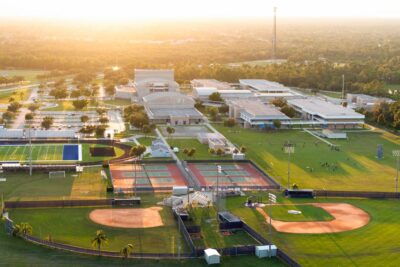How your university can better anticipate the future
April 29, 2019
Most college and university leaders accept that the future will look very different than the present and recent past for their institutions. And as we spoke with 100+ presidents, it became increasingly clear that preparing for this future is now an urgent priority. As one president put it:
“Incremental change won’t be enough for my institution to thrive into the future. We have to start shifting our future model, and it needs to happen on our current leadership team’s watch.”
The presidents we interviewed also asked us to help them start these important preparations. At the Higher Ed Strategy Forum‘s 2019 Presidential Roundtables, we convened 60+ presidents from across the U.S. and Canada to discuss innovative approaches to institutional strategic planning and the important trends shaping higher education’s future.
3 thought patterns that impede strategic thinking
Our work on strategic planning started with a focus on process. We reviewed strategic planning documents from many different colleges and universities, read popular books on strategy by notable consultants, and talked with campus leaders about their approaches. However, many of these approaches in isolation didn’t deliver on their promised results.
This challenge led us to re-evaluate our focus. Rather than concentrate on specific strategic planning processes, we started to consider how people think when planning for the future. Natural systematic tendencies in the way people think, described in psychology as cognitive biases, often interfere with our decisions.
As we reflected on the strategic planning initiatives we’ve observed, we recognized common cognitive biases that cloud our judgement about the future and impact strategic planning. We grouped them into categories:
- The here and now fallacy: The tendency to rely on our own experiences of the present and recent past when planning for the future. This cognitive bias frequently causes leaders to attribute results, both good and bad, to the actions of the institution while ignoring important external forces. Strategies built with this bias can break down when external forces change.
- The buzzword blindspot: The desire to adopt a certain innovation or follow a trend without fully considering the benefits or costs. We naturally focus on the potential benefits of an action and downplay its cost, particularly if we believe that the benefits could be significant. Whether we’re investing in a stock or launching a new program, we can easily misjudge the costs and over-estimate the potential benefits of our decisions.
- The stay the course syndrome: The adherence to a widely shared vision or belief even with evidence proving otherwise. While many institutions track their progress towards strategic goals, few re-evaluate the assumptions inherent in their strategies. As a result, they fail to adapt their strategy even as the underlying conditions change.
The Cognitive Biases that Keep Students from Succeeding
These thought patterns present a challenge for leaders responsible for making strategic decisions. However, understanding the effects of these cognitive biases provides a framework to improve our planning and visioning processes.
Beating cognitive biases to help presidents meet the student of the future
As we considered ways to help higher ed leaders overcome these cognitive biases, we were inspired by the book Leading Transformation by Nathan Furr, Kyle Nel, and Thomas Zoëga Ramsøy. The authors describe how executives at Lowe’s used the power of storytelling to shake them out of incremental thinking about change. The executives commissioned science fiction writers to draft short stories about the future of the home improvement store, which they then turned into a comic book that helped company leaders imagine new possibilities and focus on a strategic vision.
How Must we Evolve to Remain Relevant to the Student of Tomorrow?
We were struck by the potential of this thought experiment for higher ed leaders. While it’s easy to think about how individual trends might manifest in the future, it’s much more difficult to understand how multiple trends might come together to reshape universities and colleges—especially given how cognitive biases hinder our ability to evaluate future possibilities. By engaging with a selection of plausible futuristic scenarios, we can shift our mindset to think more broadly and objectively about future strategy.
Envisioning Tychaeon College: An engine of regional economic development
The idea inspired us to create a series of hypothetical future universities—schools that responded to changing markets by developing distinctive models for teaching and serving students. We imagined one of these future schools, Tychaeon College, as a higher ed institution with regional economic development at its core.
We named the school after Tyche, the Greek goddess who governs the fortunes of a city. While many colleges and universities today provide some experiential learning opportunities, concerns about the value of higher education look likely to continue.
Tychaeon College is fully integrated with its community, leasing flexible on-campus space to companies and connecting students to jobs as an integral part of their curricular experience. Students at Tychaeon College graduate having worked multiple jobs, partnered with community organizations, and built equity in campus housing cooperatives. Most importantly, the presence of organizations on campus allows students of every major to spontaneously meet and learn from a broad array of community business leaders.
Recognizing a common vision of the future
For our Presidential Roundtable series, we created marketing materials for Tychaeon and two other hypothetical future institutions. On their own, none of the scenarios represents a blueprint for success and may not even be feasible. But the value of the scenarios comes in the way they encourage us to consider multiple future possibilities for higher ed.
Roundtable participants resoundingly told us that thinking through and discussing these alternative futures with other presidents challenged their assumptions. They left the session energized to envision bold futures for their own universities, leaving with strategies to overcome incremental thinking and to bring campus stakeholders together around a common institutional direction.
More Blogs

Beyond ROI: What the New Fed Data Misses About Higher Ed’s Value Crisis

Revitalize your athletics portfolio in a tumultuous landscape
